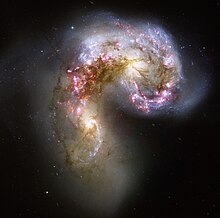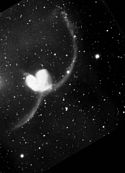NGC 4039
 Zderzające się galaktyki NGC 4038 i NGC 4039 | |
| Odkrywca | |
|---|---|
| Data odkrycia | 7 lutego 1785 |
| Dane obserwacyjne (J2000) | |
| Gwiazdozbiór | |
| Typ | spiralna z poprzeczką (SBm) |
| Rektascensja | 12h 01m 53,8s[1] |
| Deklinacja | –18° 53′ 08″[1] |
| Odległość | 62 mln ly |
| Przesunięcie ku czerwieni | 0,005474[2] |
| Jasność obserwowana | |
| Rozmiary kątowe | 3,3' × 1,7'[1] |
| Alternatywne oznaczenia | |
| ESO 572-48, MCG -3-31-15, UGCA 265, ARP 244, VV 245, PGC 37969 | |
NGC 4039 (również PGC 37969 lub UGCA 265) – galaktyka spiralna z poprzeczką (SBm), znajdująca się w gwiazdozbiorze Kruka w odległości 62 milionów lat świetlnych od Ziemi. Została odkryta 7 lutego 1785 roku przez Williama Herschela[3]. NGC 4039 i sąsiednia NGC 4038 zostały skatalogowane jako Arp 244 w Atlasie Osobliwych Galaktyk Haltona Arpa, znane są też pod nazwą Galaktyki Czułki.

Niezwykły kształt galaktyki NGC 4039 i sąsiedniej NGC 4038 jest skutkiem ich zderzenia. Zderzenie to rozpoczęło się ponad 100 milionów lat temu i trwa. Zderzenie galaktyk zainicjowało produkcję milionów gwiazd w obłokach pyłu i gazu w obu galaktykach. Najmasywniejsze z nowo powstałych gwiazd zdążyły już zużyć zapas swojego paliwa jądrowego i eksplodowały jako supernowe.
NGC 4039 należy do grupy galaktyk NGC 4038.
Zobacz też
Przypisy
Linki zewnętrzne
- NGC 4039 w serwisie SEDS.org (Revised NGC and IC Catalog) (ang.)
- NGC 4039 w bazie SIMBAD (ang.)
- NGC 4039 w NASA/IPAC Extragalactic Database (ang.)
- Zderzenie galaktyk w obiektywie wielkich obserwatoriów
Media użyte na tej stronie
Original caption from NASA: “This NASA Hubble Space Telescope image of the Antennae galaxies (NGC 4038 & 4039) is the sharpest yet of this merging pair of galaxies. During the course of the collision, billions of stars will be formed. The brightest and most compact of these star birth regions are called super star clusters.”
“ The two spiral galaxies started to interact a few hundred million years ago, making the Antennae galaxies one of the nearest and youngest examples of a pair of colliding galaxies. Nearly half of the faint objects in the Antennae image are young clusters containing tens of thousands of stars. The orange blobs to the left and right of image center are the two cores of the original galaxies and consist mainly of old stars criss-crossed by filaments of dust, which appear brown in the image. The two galaxies are dotted with brilliant blue star-forming regions surrounded by glowing hydrogen gas, appearing in the image in pink.”

